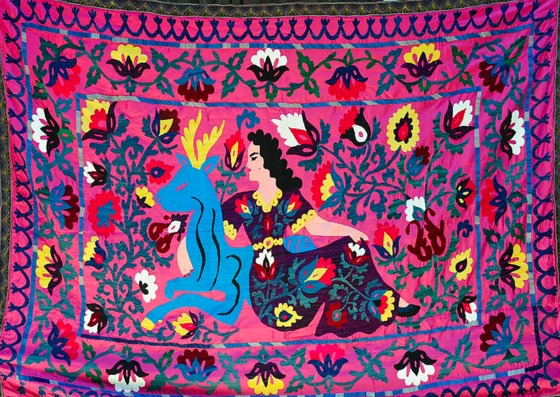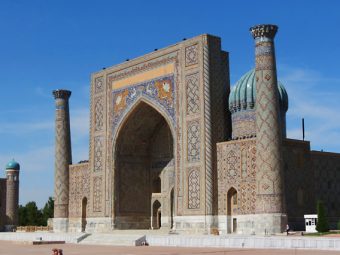And so, after silk printing and ikat, onto the third amazing member of the Uzbek textile tradition: the splendid world of Suzani, the ancient art of embroidery. Behold the world where magic is wrought with every stitch.
Photo by Kellie CA
What are suzanis and where do they come from?
The word itself comes from the Persian word for “needle,” and describes embroidered hangings or fabric coverings. Unlike its two sister traditions, silk printing and ikat, suzanis actually originate from Uzbekistan.
Ikat is luxury, and silk printing is everyday décor – where does suzani come in?
As you know, Central Asia has always been a land of textiles. In particular, women have long decorated every object they could— saddlecloths, prayer rugs, tent flaps, salt bags, cradle covers, yurt bands, mirror cases, gift wraps and so on — with woven, embroidered or printed wool, silk, cotton or felt textiles, so there is a lot of overlap in where the finished products wrought from all the various materials and techniques ended up in their lives.
Okay, but where was suzani more important?
Well, there was one area: dowries. As children, both nomad and village girls began putting theirs together to show the community their skill and industriousness. Also, over and above this, all through their lives their textiles were the main means of expression and of control of their immediate surroundings, whether it was a house, a tent or a yurt. Then, of course, the textiles were also, if it came to it, an economic resource, as fine pieces could be easily sold, and city dwellers often commissioned work from the village women.
Then their work was as recognized and valued as men’s?
Indeed. It was taken for granted that homes should grow into cocoons of sumptuous textiles that were not only beautiful and functional, but also served as links to history and status symbols. Many patterns that are largely abstract now, or so stylized as to seem abstract, have very old roots.
How were they used in determining status?
As you’ve seen, Central Asia is not just a topographical but a human patchwork too; Turkomans, Kyrgyz, Khazakhs, Uzbeks, Arabs and Lakai live there. Inevitably, individual regions developed their distinctive designs and, within those groups, every tribe had its own göl, or crest, with colors and motifs that clearly marked out at a marketplace or on pilgrimage. If one tribe ranked below another, as was the case with client-protector tribe dynamics, the client tribe’s elders placed the göl of their protector more prominently than their own. As with western heraldry, these crests accurately depicted the past history and the present “pecking order” of the respective tribes.
Which regional centres are most famous for suzanis?
There are many variations on the theme and each style has its own region still, but if you had to pick just one Uzbek city, it would have to be Bukhara. Textiles here also include spectacular, distinctive rugs and ikat fabrics, but suzanis are most important of all. Bukhara is A UNESCO world heritage site, and has a very long and literally colorful history that dates back at least fifteen hundred years. It has an amazing section dedicated to it in its museum too.
Where can I buy real Uzbek suzanis?
Everywhere in Central Asia! Fortunately, the tradition is alive and well: some are hand-embroidered too. The current fashion in designs may not be as distinctive as in the past, but in this very recent form, the tradition of the suzani lives on, so yes, you’re bound to be able to pick one up on your Central Asia Rally.






Leave a Reply